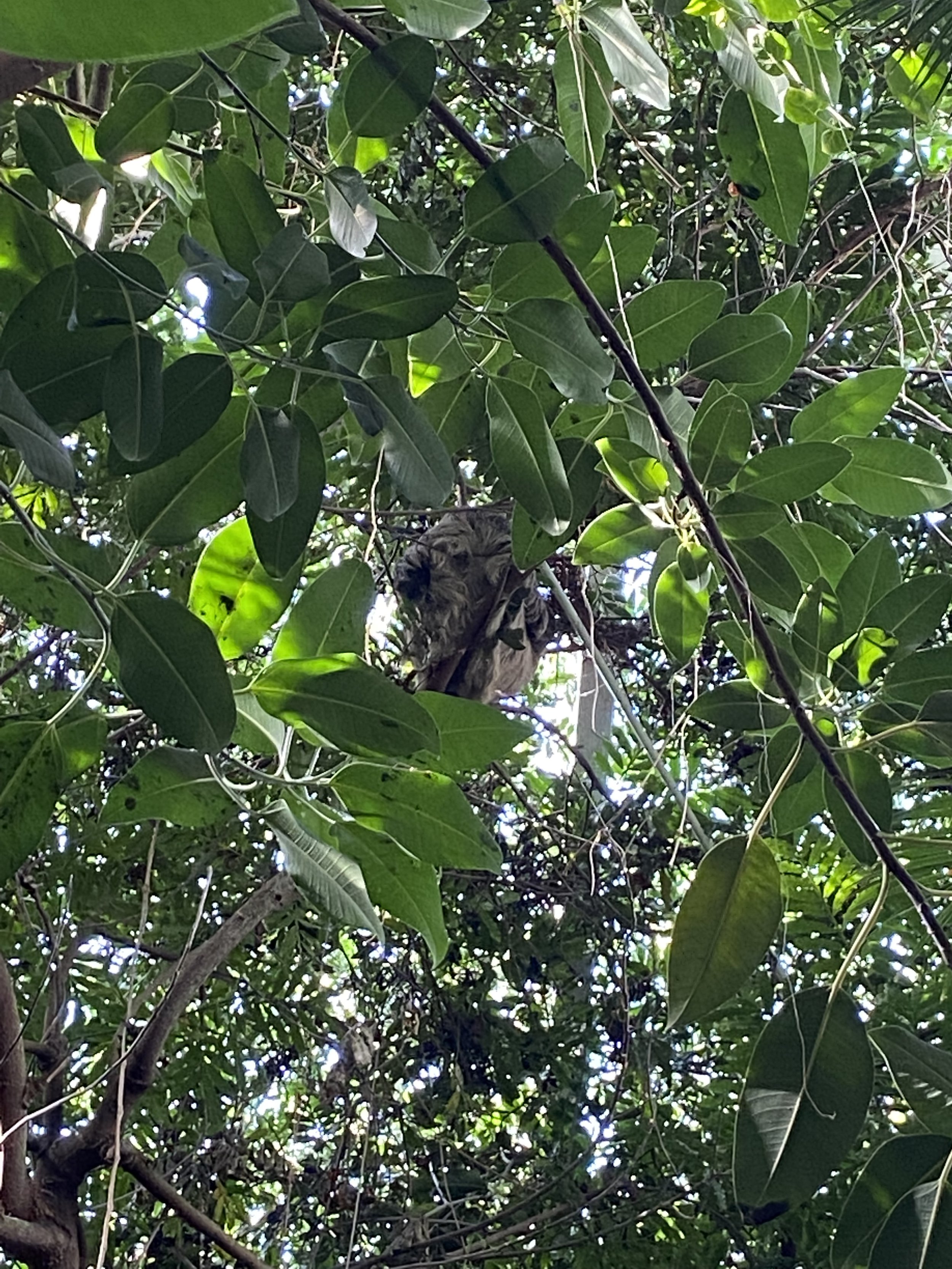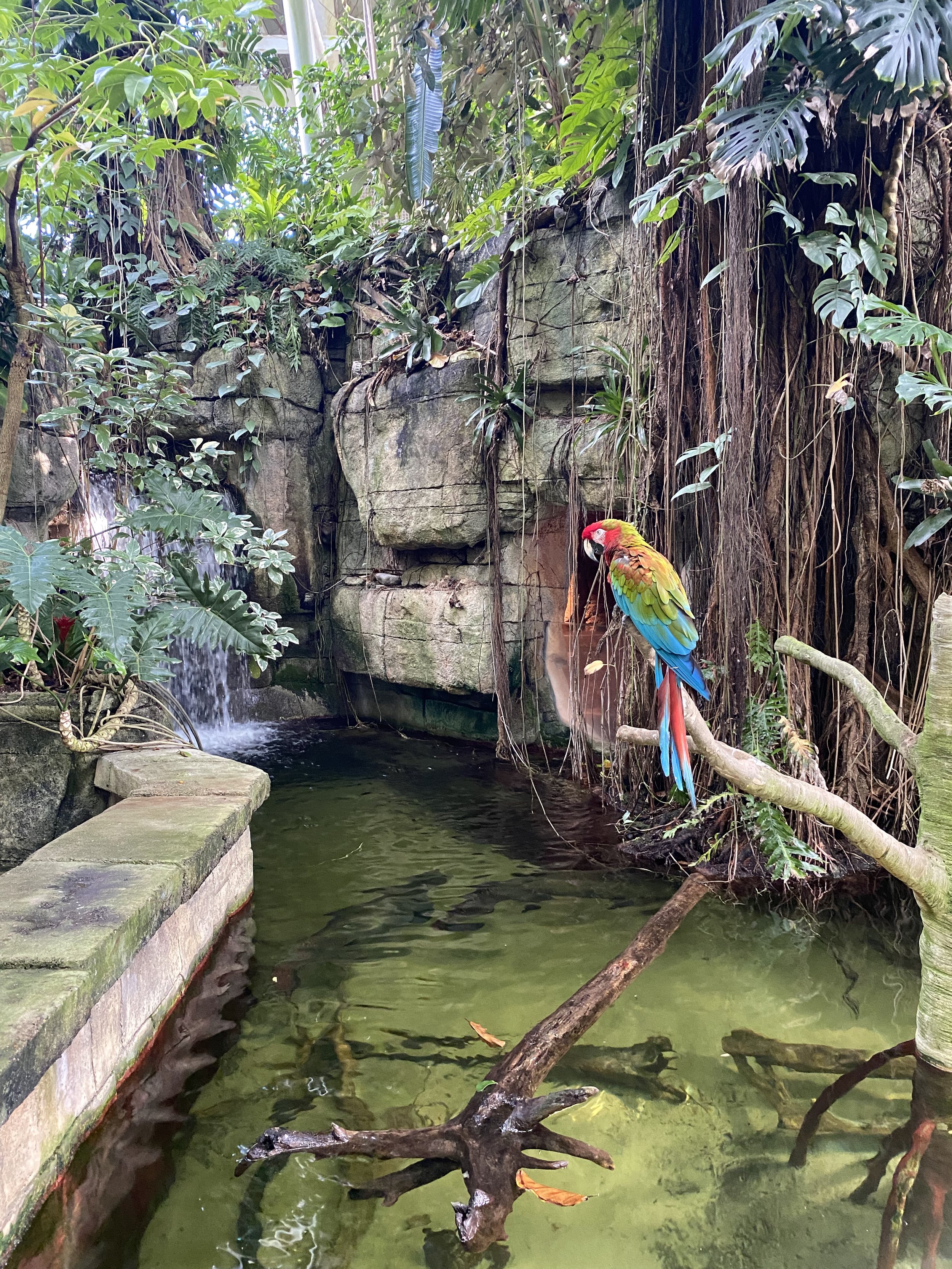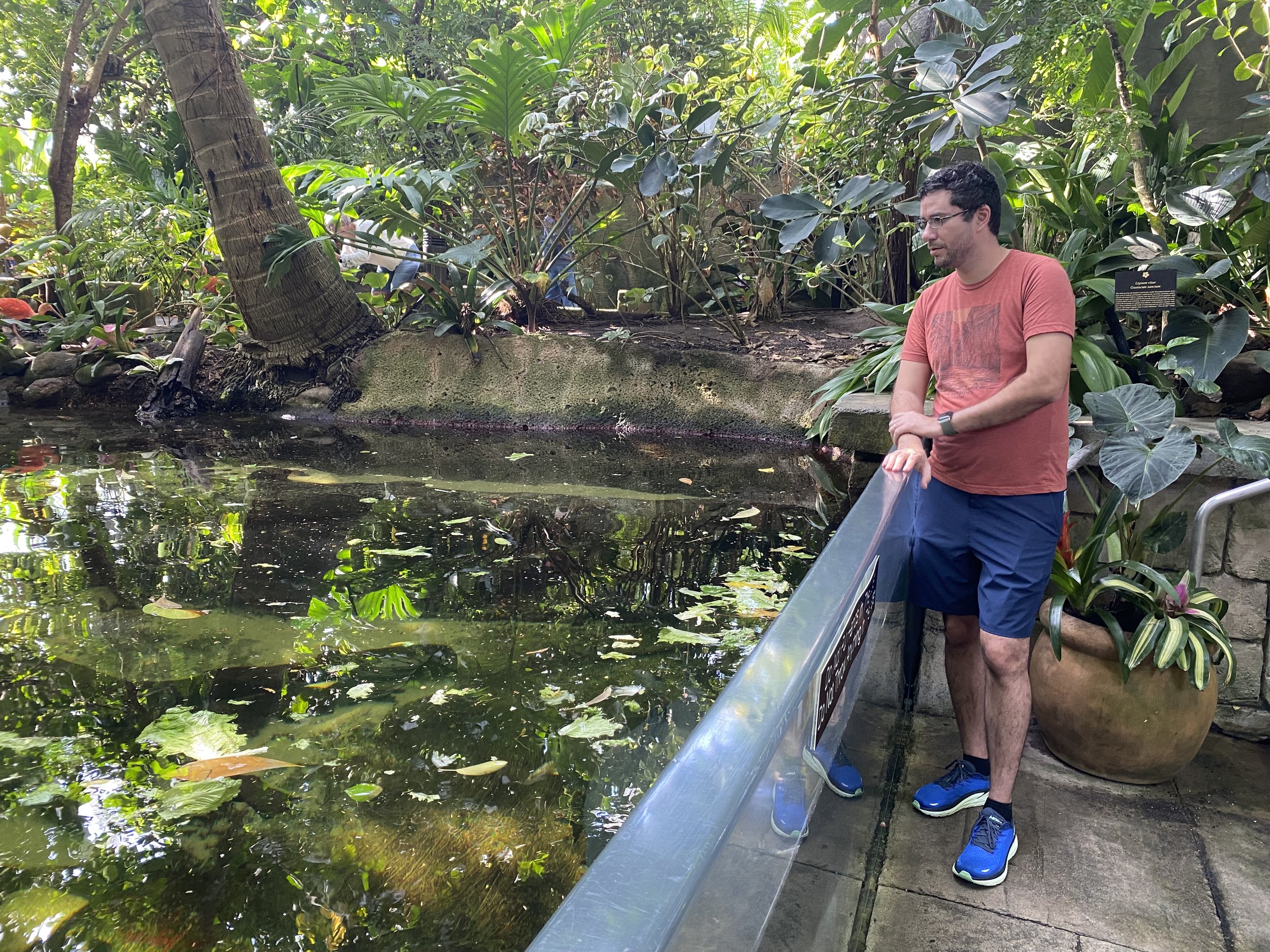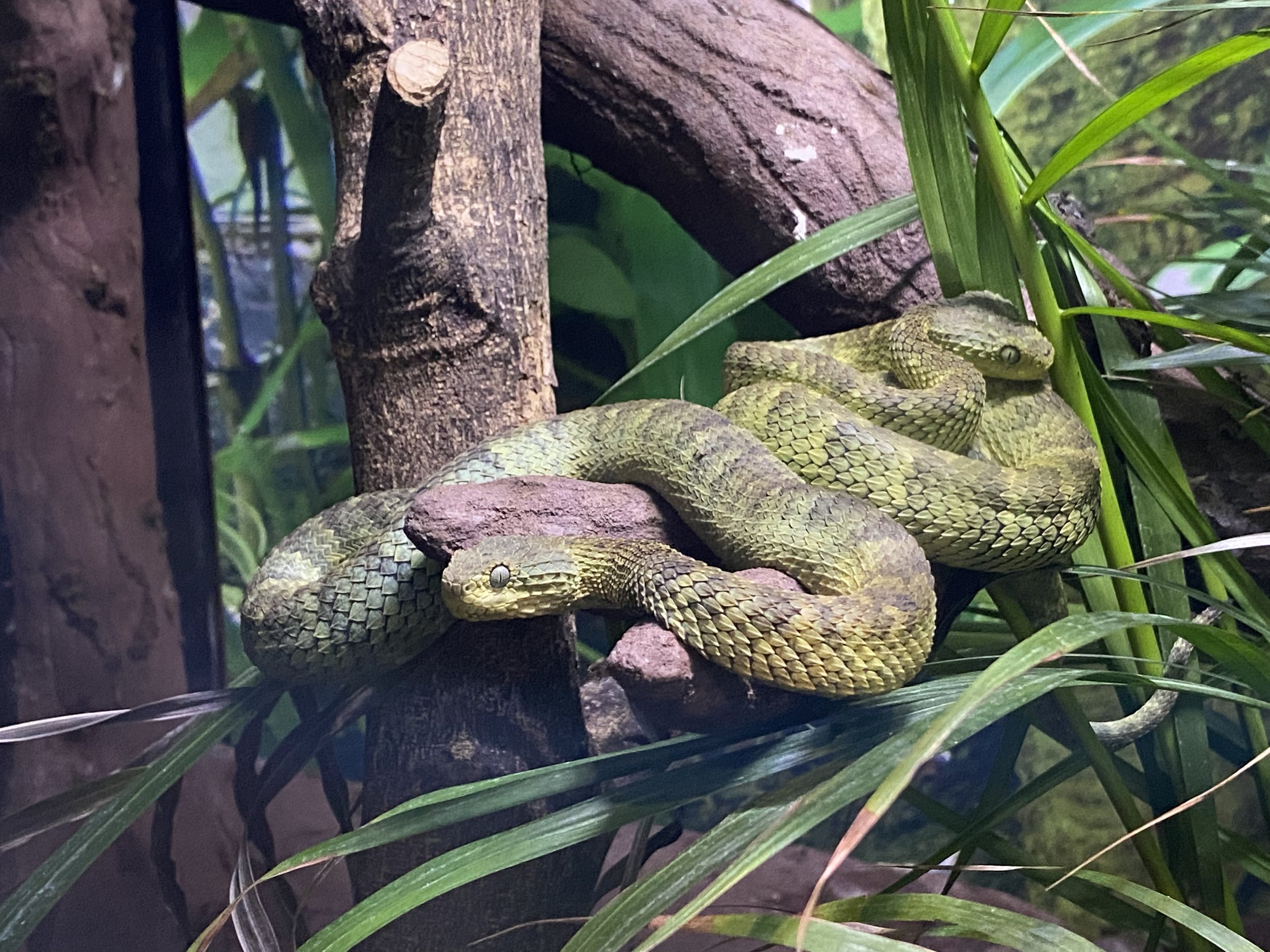Swaddled in Color: A Walk Through the Rainforest Pyramid at Moody Gardens
January 11th, 2023
Just when we thought Houston couldn’t get any more humid, you and I enter a rainforest encased in a glass pyramid at Moody Gardens. I grin as I am transported into a fabricated jungle, where the air is thick with the smell of nature and murky water, and filled with the calls of tropical birds. Hand in hand, we mosey onto a suspended walkway among the treetops, catching our first sight of wildlife amid the vibrant array of foliage, vines, banana leaves, and palm sprays.
Two white African spoonbills perch atop the bleached rafters of the pyramid, picturesque against the glass that overlooks the park. As we pass through a tiki hut and round the corner, we encounter a white-faced saki—a monkey much smaller than her fur would suggest—carefully grooming her thick black tail. She is unafraid, though sitting only a couple of yards away from us on the guard rail. A few paces further and I am face-to-face with a colony of Rodrigues fruit bats, deftly crawling up a net, where they hang from their feet and wrap their golden-necked, fur-coated bodies in built-in sleeping bags of massive, black, rubbery wings.
I am nearly over-stimulated. Never in the wild would we have the luck to see so many species in such a short period of time. Peering down over the bridge’s railing, I spot where our trail will take us. Tourists stand beside a large pool of water—glistening in the patches of light that break the shady atmosphere—and they are miniaturized by the shocking size of the pool’s aquatic inhabitants.
We descend through a tunnel to the lower level of the pyramid, where we no longer see but glimpses of the white beams that hold up the glass sky. Ripples of light bounce from water onto the underbelly of the bridge we were just on. We walk through drapes of hanging moss that tickles my head, and I admire the vibrant orchids that have been carefully placed among them. We are swaddled in color: purple plumes and magenta foliage, yellow fans and peach-colored palm stalks, scattered throughout every shade of green in every possible shape. Long whistles, raspy trills, and the stuttering cry of loons are joined by the sound of rushing water, and something like the croak of a frog—or perhaps a monkey. Was that an elephant I just heard? The jungle plays tricks on my ears, and holds its secrets from me.
Suddenly, a navy and maroon-colored bird struts out onto the path before us, his long tail bobbing proudly up and down. Before I have fully had a chance to admire him, I spot another one, pigeon-like with a blue head and orange chest, nestled upon a rock beside me. Squatting in the bushes near it are adorable red-crested roul roul partridges. My attention is yet again drawn away as a pair of steel-blue birds the size of chickens, adorned in plumage fit for the horse races, walk alongside us on the trail. They peek in through the glass of the komodo dragon habitat as if they themselves were tourists, watching as the alligator-sized beast saunters under fallen tree limbs, his powerful forearms leading his sway back and forth.
We pause at a pond where I catch the same African spoonbill sisters we saw earlier smacking bills with one another in the water—whether in an affectionate dance or a threatening face-off, I do not know. Behind them trickles the tiniest of waterfalls, which drips down vines like wet hair, reaching for the pool below. Amid them flash pops of bright yellow and orange as two small birds bathe and fluff their wings, cheerfully chirping all the while.
I trail my fingers across the smooth bamboo stalks that fence off netted sanctuaries as we continue our walk. Someone points out a two-toed sloth sleeping in a wad of thick cream and gray fur in a tree above us; but no matter how long I stare, I still can’t tell where she begins or ends. I am startled from my focus as a black bird with a yellow beak and tail vibrates its wings in some kind of dance, his voice mechanical as the trill of an old PAC Man machine. As his cry subsides, I notice movement in a nearby tree. As I strain to make it out, the shape suddenly opens like an umbrella, as a pair of massive unfurled wings float ominously in my direction. I grin as the bird swerves at the last second, casting a breeze on my face, and lands on the boulder behind me.
Our blue friends, the Victoria crowned pigeons, periodically rejoin us on the trail like a pair of loyal dogs. They veer off as we enter a clearing around a tranquil pool filled by a rushing waterfall, around which bob bright pink scarlet ibises, dipping their curved beaks in and out of the water. An azul-colored parrot perches above a white-blotched river stingray, who sleeps among colossal fish beneath a pair of black turtles resting on a log at the water’s surface. We stay here a while, now acclimated to the sweaty climate and happily soaking in the scene.
Neighboring the oasis is a structure made to imitate an ancient Mayan temple, crowned with overgrowth. We enter to find an aquarium, and I strain my eyes to discover what it houses. My heart leaps in my chest as I realize the monumental log in the tank is not a log at all, but an anaconda! Laughing away the shock (and grateful we are separated from the snake by a sheet of glass), we quickly move on down an adjacent tunnel, which bends behind the waterfall we witnessed outside, now roaring in our ears. Across from it, illuminated in red light, are a family of vampire bats.
Smaller than the palm of my hand, the vampire bats crawl across the stone backdrop and huddle in clusters from the ceiling—their trembling, furry bodies curled up like kittens, flicking their pointed ears and opening their pug noses to emit silent cries of echolocation. Some preen and stretch their paper-thin wings, more fragile than wishbones; but don’t be fooled. At the base of the habitat, they feed on cups of blood.
As we near the exit of the pyramid at last, our blue Victoria crowned pigeons at our heels, we admire one final habitat, in which miniscule duiker deer groom themselves with tiny tongues. They are not the star of this show, however. Roosting close enough for me to see his eyelashes, a stately hornbill eyes us skeptically, like a judge about to lower his hammer. He opens his vast ketchup and mustard beak at us in criticism, as if to say, you don’t belong here, or, this isn’t real. Be that as it may, I am grateful for the illusion that allowed us to traverse tropics otherwise out of reach, where we have been privileged to witness one vibrant painting in God’s art gallery.








































